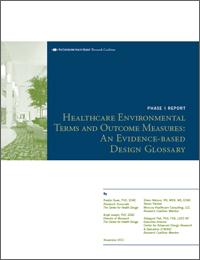Healthcare Environmental Terms and Outcomes Measures: An Evidence-based Design Glossary

Objective: A key issue increasingly restricting the development and application of evidence-based design (EBD) research is the lack of a standard glossary of terms, definitions, metrics, and measurement tools. As the first step of developing a standard EBD glossary, a comprehensive literature review was conducted to identify variables and metrics in existing EBD research that examined relationships between environmental elements and healthcare outcomes in seven high-priority topic areas: healthcare-associated infections (HAIs), medical errors, patient falls, patient satisfaction, patient waiting, staff efficiency, and staff satisfaction.
Methods: Through an extensive literature search, relevant research publications in each topic area were identified. A total of more than 130 articles were selected for detailed analysis. In each topic area, a table of article analysis was created to compile the relevant information extracted from the literature including: environmental variables, outcomes measures, metrics, measurement tools, and other research information. Definitions and metrics used in the literature for environmental variables and outcome measures were summarized into a glossary table. The relationships between environmental variables and outcomes in each topic area were depicted by a matrix of relationships and a conceptual framework. In the final step, results from the seven topic areas were synthesized into two overall glossary tables-one of environmental variables and one for outcomes.
Findings: A total of 50 environmental variables and 35 outcomes were identified and defined. Environmental variables were typically measured on categorical scale and manipulated by designers or researchers as independent variables. Other measurement methods of environmental variables included both subjective (e.g., questionnaire) and objective measures (e.g., tracer gas concentration decay technique). Almost all outcome variables were measured on an interval/ratio scale. Patient safety outcomes were typically measured by the prevalence of safety incidents and the severity of consequences and were often collected through the review of incident reports and medical records and the observation of healthcare processes. Direct observation was a key method of measuring patient and staff behaviors. Questionnaire survey was used to collect subjective outcomes such as satisfaction and stress. Other measurement methods of outcomes included computer simulation and technical methods such as electrocardiography monitoring. Inconsistency or variation in defining and measuring environmental variables and outcomes posed threats to the validity as well as the generalizability of research.
Conclusions: The first phase work generated useful resources for healthcare design and research and identified strengths, weaknesses, and gaps in the term definitions, metrics, and measurement tools. Future phases will focus on expanding the list of terms and definitions to other topic areas as well as developing more powerful tools and measures.


Add comment
Log in to post comments